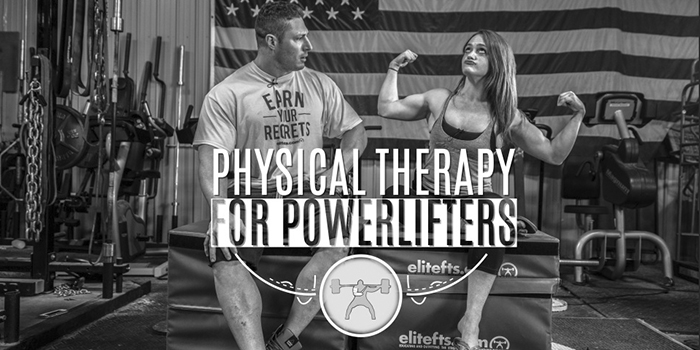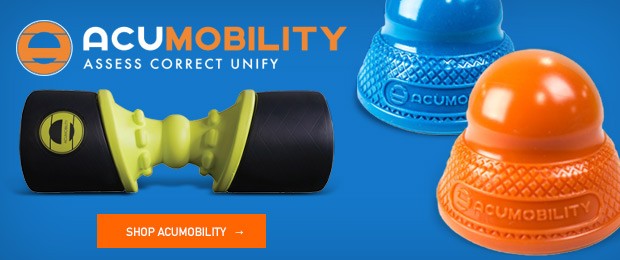
“In order to get Casey out of his right hip and stop the rightward shift, I need to get him into his left hip.”
This statement really is the big picture of the exercise in this video: getting “into” the left hip and improving how well the socket receives the ball. We have a number of structural things in place (think ligaments, bone orientation, joint congruency) that influence how well the ball and socket moves. All of these played a role in why Casey couldn’t get into his left hip as he increased the degree of hip flexion (squat eccentric).
WATCH: Physical Therapy — Anterior Pelvic Tilt Fix with Casey Williams and Dani Overcash
Casey had a few really great points that he brought up in the video and that I concur with. There are few key ones I’d like to highlight:
- Left foot slightly higher than right: this puts you in small degrees of relative internal rotation. Most people reading this will say they lack internal rotation. There’s a reason for that, but it is beyond the scope of this short rundown. It should, however, be a goal to restore that while addressing why the rotation is limited to begin with.
- Keeping low back rounded: this is a similar theme to what we did with him. Really, it's kind of the bread-and-butter we addressed. It’s important to note that we didn’t necessarily go into tons of rounding or flexion, but enough that it alternated him outside his normal extended/anteriorly tilted pattern. Take hold of this concept. I think this was one of the foundational building blocks that gave Casey something to work with when it came time to train.
- SMALL movements and muscle contractions: Casey mentioned this isn’t like getting tight under a bar. You’re utilizing muscles in a position (think muscle length) that is foreign to the muscle, so although you may not be asking “much” of it in terms of your perceived demand, from that position and that length, it is hard for the muscle to work. You may need to start with a very small squeeze/shift. Think about the volume on a TV, and gradually dial it up just enough that you can find your left knee behind the right (without losing too much low back position) and barely feel your left inner thigh. It won’t feel like much. This is neurologic and positional change — so different from what we’re used to feeling under a bar.
- Inhaling and exhaling: really emphasize the breathing, just the way Casey explained it. The more subtle, the better. Envision the socket receiving the ball in the hip joint. Be sure to pause at the end of your exhale.
- Another stretch: I mention that if you feel excessive hip tightness or even cramping in your left inner thigh, you may benefit from another stretch. I have a video of it posted in a previous article, called the “ischiofemoral ligamentous stretch.” When that range of motion isn’t accessed because we’ve been in a pattern for too long, tissue gets tightened down. It’s hard to get into a left hip if the tissue isn’t primed for it.
Remember, as much as this is a huge portion of addressing “why” his pain existed, this was not the only thing we did to address his mechanics. What it did do, however, was help to create an environment that permitted more normal muscle length/position, and created more of an anchor onto/into his left side.
Pro Tips from Casey
Remember, this is specific to my hip dysfunction. We're working here to get my left hip back into the socket and creating an “anchor point” which almost acts like a form of feedback for my body while I’m squatting. Keep in mind, while I was having all of these issues and blatantly leaning to the right in my squat, I felt square. It became so natural that I didn’t even see it on video because my eyes and my body were accustomed to it. So part of this was to give my body a chance to become self aware again so I could autocorrect poor positioning.
- Be picky (again). It will do you no good to lay there with anything on your mind other than fixing your squat. You have to be in tune with your body.
- Obliques. This is your anchor point, but be gentle. Think 10% effort when "flexing" or activating it.
- Hips. Have your left foot elevated, making the left knee rotate inward. DO NOT rotate your hip backward to pull your left knee backward. Gently pull that left knee back, focusing on the feeling in your hip. It’s very subtle.
- Adductors. Squeeze. I squeezed really hard in the beginning and kept cramping. Once Dani realized this, she said, "that’s enough, numb nuts." So again, be gentle. Think 20-40% activation for the adductor. Get it firing and let it feel a little bit fatigued. After doing it properly for a couple weeks, that fatigue starts to fade and the activation becomes easier.
- Breathe. Inhale pulling the knee back; exhale squeezing the adductor. Patience. Purpose.
So if you’re not noticing yourself shift to one side or the other, work this rehab from both your left and ride side. See if you can feel one adductor fire better than the other. See if one hip pulls back into socket easier than the other.
Continue watching this seven-part weekly series for exercises that helped mediate Casey's hip shift and dysfunction.









